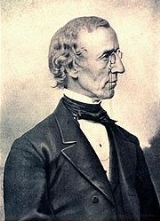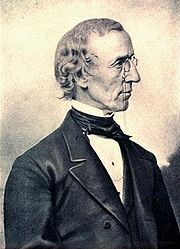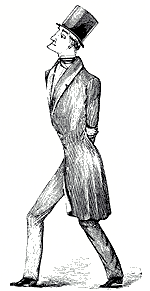
Jeffries Wyman
Encyclopedia

United States
The United States of America is a federal constitutional republic comprising fifty states and a federal district...
naturalist
Natural history
Natural history is the scientific research of plants or animals, leaning more towards observational rather than experimental methods of study, and encompasses more research published in magazines than in academic journals. Grouped among the natural sciences, natural history is the systematic study...
and anatomist, born in Chelmsford, Massachusetts.
Chelmsford, Massachusetts
Chelmsford is a suburban town in Middlesex County, Massachusetts in the Greater Boston area. As of the 2010 United States Census, the town's population was 33,802. The Census Bureau's 2008 population estimate for the town was 34,409, ranking it 14th in population among the 54 municipalities in...
Wyman died in Bethlehem, New Hampshire
Bethlehem, New Hampshire
Bethlehem is a hillside town in Grafton County, New Hampshire, United States. The population was 2,526 at the 2010 census. It is home to Cushman and Strawberry Hill state forests. The eastern half of the town is within the White Mountain National Forest...
of a pulmonary hemorrhage
Pulmonary hemorrhage
Pulmonary hemorrhage is an acute bleeding from the lung, especially in the upper respiratory tract and the endotracheal tube. When evident clinically, the condition is usually massive, associated with bleeding in other sites as well as more than one third of the lungs...
.
Career
He graduated Harvard CollegeHarvard College
Harvard College, in Cambridge, Massachusetts, is one of two schools within Harvard University granting undergraduate degrees...
in 1833 and Harvard Medical School
Harvard Medical School
Harvard Medical School is the graduate medical school of Harvard University. It is located in the Longwood Medical Area of the Mission Hill neighborhood of Boston, Massachusetts....
in 1837. He was made curator
Curator
A curator is a manager or overseer. Traditionally, a curator or keeper of a cultural heritage institution is a content specialist responsible for an institution's collections and involved with the interpretation of heritage material...
at Lowell Institute
Lowell Institute
The Lowell Institute is an educational foundation in Boston, Massachusetts, U.S.A., providing for free public lectures, and endowed by the bequest of $250,000 left by John Lowell, Jr., who died in 1836. Under the terms of his will 10% of the net income was to be added to the principal, which in...
, Boston
Boston
Boston is the capital of and largest city in Massachusetts, and is one of the oldest cities in the United States. The largest city in New England, Boston is regarded as the unofficial "Capital of New England" for its economic and cultural impact on the entire New England region. The city proper had...
, in 1839 and remained affiliated there until 1842. Fees from Lowell Institute lectures enabled him to study in Europe
Europe
Europe is, by convention, one of the world's seven continents. Comprising the westernmost peninsula of Eurasia, Europe is generally 'divided' from Asia to its east by the watershed divides of the Ural and Caucasus Mountains, the Ural River, the Caspian and Black Seas, and the waterways connecting...
, from 1841-842, where he had the opportunity to study under anatomist Richard Owen
Richard Owen
Sir Richard Owen, FRS KCB was an English biologist, comparative anatomist and palaeontologist.Owen is probably best remembered today for coining the word Dinosauria and for his outspoken opposition to Charles Darwin's theory of evolution by natural selection...
in London. Upon his return to the United States, he had hoped to gain a professorship at Harvard College but the position went to Asa Gray
Asa Gray
-References:*Asa Gray. Dictionary of American Biography. American Council of Learned Societies, 1928–1936.*Asa Gray. Encyclopedia of World Biography, 2nd ed. 17 Vols. Gale Research, 1998.*Asa Gray. Plant Sciences. 4 vols. Macmillan Reference USA, 2001....
. In 1843, he was elected professor
Professor
A professor is a scholarly teacher; the precise meaning of the term varies by country. Literally, professor derives from Latin as a "person who professes" being usually an expert in arts or sciences; a teacher of high rank...
of anatomy
Anatomy
Anatomy is a branch of biology and medicine that is the consideration of the structure of living things. It is a general term that includes human anatomy, animal anatomy , and plant anatomy...
and physiology
Physiology
Physiology is the science of the function of living systems. This includes how organisms, organ systems, organs, cells, and bio-molecules carry out the chemical or physical functions that exist in a living system. The highest honor awarded in physiology is the Nobel Prize in Physiology or...
at Hampden-Sydney College
Hampden-Sydney College
Hampden–Sydney College is a liberal arts college for men located in Hampden Sydney, Virginia, United States. Founded in 1775, Hampden–Sydney is the oldest private charter college in the Southern U.S., the last college founded before the American Revolution, and one of only three four-year,...
, Richmond
Richmond, Virginia
Richmond is the capital of the Commonwealth of Virginia, in the United States. It is an independent city and not part of any county. Richmond is the center of the Richmond Metropolitan Statistical Area and the Greater Richmond area...
, Virginia
Virginia
The Commonwealth of Virginia , is a U.S. state on the Atlantic Coast of the Southern United States. Virginia is nicknamed the "Old Dominion" and sometimes the "Mother of Presidents" after the eight U.S. presidents born there...
. A series of letters written between 1843 and 1848 to his Boston friend and fellow M.D., David Humphreys Storer, reveal his unhappiness with the quality of the school, the treatment of the professors, and life in the South, writing "as soon as circumstances will permit I shall make my way back to the glorious city of Boston, the like of which exists not on the face of the earth." In 1847, he got his wish when he became Hersey Professor of Anatomy at Harvard College, where he remained until his death, becoming the first curator of the Peabody Museum of Archaeology and Ethnology
Peabody Museum of Archaeology and Ethnology
The Peabody Museum of Archaeology and Ethnology is a museum affiliated with Harvard University in Cambridge, Massachusetts, USA.Founded in 1866, the Peabody Museum is one of the oldest and largest museums focusing on anthropological material, and is particularly strong in New World ethnography and...
there in 1866. He made extensive and valuable collections in comparative anatomy
Comparative anatomy
Comparative anatomy is the study of similarities and differences in the anatomy of organisms. It is closely related to evolutionary biology and phylogeny .-Description:...
and archæology
Archaeology
Archaeology, or archeology , is the study of human society, primarily through the recovery and analysis of the material culture and environmental data that they have left behind, which includes artifacts, architecture, biofacts and cultural landscapes...
, and he published nearly 70 scientific papers. He was the president
President of the American Association for the Advancement of Science
The American Association for the Advancement of Science , founded in 1848, is the world's largest general scientific society. It serves 262 affiliated societies and academies of science and engineering, representing 10 million individuals worldwide...
of the American Association for the Advancement of Science
American Association for the Advancement of Science
The American Association for the Advancement of Science is an international non-profit organization with the stated goals of promoting cooperation among scientists, defending scientific freedom, encouraging scientific responsibility, and supporting scientific education and science outreach for the...
in 1858. Although he did not achieve the fame of some of his contemporaries, he was respected by peers: "In his special branches his authority was recognized the world over."
Colleagues
In addition to studying with Richard Owen in London in 1842, Wyman also attended lectures by Achille ValenciennesAchille Valenciennes
Achille Valenciennes was a French zoologist.Valenciennes was born in Paris, and studied under Georges Cuvier. Valenciennes' study of parasitic worms in humans made an important contribution to the study of parasitology...
, Isidore Geoffroy Saint-Hilaire
Isidore Geoffroy Saint-Hilaire
Isidore Geoffroy Saint-Hilaire was a French zoologist and an authority on deviation from normal structure. He coined the term ethology.He was born in Paris, the son of Étienne Geoffroy Saint-Hilaire...
, Marie Jean Pierre Flourens
Jean Pierre Flourens
Marie Jean Pierre Flourens , father of Gustave Flourens, was a French physiologist, the founder of experimental brain science and a pioneer in anesthesia....
, and Etienne Serres
Étienne Serres
Antoine Étienne Renaud Augustin Serres was a French physician and embryologist.In 1810 Serres received his medical doctorate in Paris, and afterwards worked at the Hôtel-Dieu de Paris and the Hôpital de la Pitié. Beginning in 1839 he taught comparative anatomy at the Jardin des Plantes. In 1841 he...
in Paris. At Harvard, his colleagues included Oliver Wendell Holmes
Oliver Wendell Holmes, Sr.
Oliver Wendell Holmes, Sr. was an American physician, professor, lecturer, and author. Regarded by his peers as one of the best writers of the 19th century, he is considered a member of the Fireside Poets. His most famous prose works are the "Breakfast-Table" series, which began with The Autocrat...
, Asa Gray, and Louis Agassiz
Louis Agassiz
Jean Louis Rodolphe Agassiz was a Swiss paleontologist, glaciologist, geologist and a prominent innovator in the study of the Earth's natural history. He grew up in Switzerland and became a professor of natural history at University of Neuchâtel...
. He also with American physician and missionary Thomas Staughton Savage first scientifically described Gorilla
Gorilla
Gorillas are the largest extant species of primates. They are ground-dwelling, predominantly herbivorous apes that inhabit the forests of central Africa. Gorillas are divided into two species and either four or five subspecies...
s. Holmes also testified in the Parkman-Webster Murder Case
Parkman-Webster murder case
The Parkman-Webster murder case was a highly publicized crime, investigation, and trial that shook the American city of Boston, Massachusetts to its core in 1849–1850, due to the crime's gruesome nature and the high social station of the victim and murderer....
. After Wyman's death, his former student Burt G. Wilder
Burt Green Wilder
Burt Green Wilder was an American comparative anatomist, born in Boston to David and Celia Colton Wilder. He graduated at Harvard , 1862; medical department, 1866). During part of the Civil War he served as surgeon of the Fifty-fifth Massachusetts Infantry...
eulogized him as "regarded by all as the highest anatomical authority in America, and the compeer of Owen, Huxley, and Gegenbauer in the Old World."
Parkman-Webster Murder Case

Parkman was a frequent walker on the streets of Boston, collecting his rents. "His gaunt figure was easily identified and not readily forgotten." A sketch of Dr. Parkman as he was last seen was published in the New York Globe's account of the trial. While the bones could not be definitively identified as Dr. Parkman, Wyman contributed to the belief that they were Parkman's by providing the court with a "diagram, exhibiting the position in the skeleton, of the bones found and showing, (in some degree,) what would be necessary to complete the body." This rendering was remarkably similar in stance to the striding picture of Dr. Parkman and indeed labeled "Restoration of Dr. Parkman's Skeleton," no doubt influencing the jury.
Oddly enough, Wyman's brother, Dr. Morrill Wyman
Morrill Wyman
Morrill Wyman was an American physician and social reformer. Best known today for his work on hay fever, he was one of the most respected doctors of his time, a social reformer, Harvard overseer, hospital president, and author in his long lifetime.Wyman was the son of Dr...
and his wife had spent the evening of Parkman's disappearance with Webster and his wife at the home of Harvard professor Daniel Treadwell.
Views on Evolution and Correspondence with Darwin
Wyman was a theistTheism
Theism, in the broadest sense, is the belief that at least one deity exists.In a more specific sense, theism refers to a doctrine concerning the nature of a monotheistic God and God's relationship to the universe....
who attended the Unitarian Church at Harvard and as such leaned toward a belief in a "theistic, morphological form of evolution rather than natural selection." Two historians of science who chronicles Wyman's career, A. Hunter Dupree
A. Hunter Dupree
Anderson Hunter Dupree is a distinguished American historian and one of the pioneer historians of the history of science and technology in the United States.-Early Education and Education:...
and Toby Appel, disagreed as to Wyman's reception of Darwin's
Charles Darwin
Charles Robert Darwin FRS was an English naturalist. He established that all species of life have descended over time from common ancestry, and proposed the scientific theory that this branching pattern of evolution resulted from a process that he called natural selection.He published his theory...
theories of evolution
Evolution
Evolution is any change across successive generations in the heritable characteristics of biological populations. Evolutionary processes give rise to diversity at every level of biological organisation, including species, individual organisms and molecules such as DNA and proteins.Life on Earth...
and natural selection
Natural selection
Natural selection is the nonrandom process by which biologic traits become either more or less common in a population as a function of differential reproduction of their bearers. It is a key mechanism of evolution....
. Dupree believed that Wyman's religious beliefs caused him to struggle with Darwin's theories, accepting them "only by intense effort both as a scientist and a person." Appel disagreed with Dupree, believing that Wyman had no difficulty accepting Darwin's theory of evolution but that his work in philosophical anatomy made it "doubtful that he ever accepted natural selection." In her article, Appel makes a case for Wyman as a proponent of philosophical anatomy at Harvard, along with Louis Agassiz and Asa Gray. Philosophical anatomy, also known as transcendental anatomy, was the "search for ideal patterns of structure in nature." This search did not prevent Wyman and Gray in accepting evolution, although Agassiz never did. However, unlike Gray, Wyman could not accept natural selection as the method of evolution, believing instead in evolution as "directed by the Creator."
When On the Origin of Species was published in 1859, Wyman's one-time mentor, Richard Owen
Richard Owen
Sir Richard Owen, FRS KCB was an English biologist, comparative anatomist and palaeontologist.Owen is probably best remembered today for coining the word Dinosauria and for his outspoken opposition to Charles Darwin's theory of evolution by natural selection...
came out against the book, while his colleague Asa Gray supported it. In 1860, Darwin
Charles Darwin
Charles Robert Darwin FRS was an English naturalist. He established that all species of life have descended over time from common ancestry, and proposed the scientific theory that this branching pattern of evolution resulted from a process that he called natural selection.He published his theory...
went to Gray to enlist Wyman's support due to Wyman's work on higher apes and anatomy. Wyman wrote to Darwin agreeing that "progressive development is a far more probable theory than progressive creations", and the two men corresponded between 1860 and 1866, with Darwin writing at one point "I know hardly anyone whose opinions I should be more inclined to defer to."
Personal life
Wyman was married in 1850 to Adeline Wheelwright, with whom he had two daughters, Mary and Susan. Wheelwright died in 1855 and in 1861, he married Annie Williams Whitney, with whom he had a son, Jeffries Wyman, Jr. Whitney died in 1864, the year of their son's birth. In 1978, the Peabody Museum published Dear Jeffie, a charming collection of letters and sketches that Wyman had written to his son from 1866 to 1874 (the year of his own death) when he was doing field work in the states and abroad. His brother Dr. Morrill WymanMorrill Wyman
Morrill Wyman was an American physician and social reformer. Best known today for his work on hay fever, he was one of the most respected doctors of his time, a social reformer, Harvard overseer, hospital president, and author in his long lifetime.Wyman was the son of Dr...
was a respected Cambridge
Cambridge, Massachusetts
Cambridge is a city in Middlesex County, Massachusetts, United States, in the Greater Boston area. It was named in honor of the University of Cambridge in England, an important center of the Puritan theology embraced by the town's founders. Cambridge is home to two of the world's most prominent...
doctor; their father Dr. Rufus Wyman was the first director of the McLean Asylum
McLean Hospital
McLean Hospital is a psychiatric hospital in Belmont, Massachusetts.It is noted for its clinical staff expertise and ground-breaking neuroscience research...
. Ironically, Dr. George Parkman had sought the directorship of the asylum, another connection between Parkman and the Wymans.

